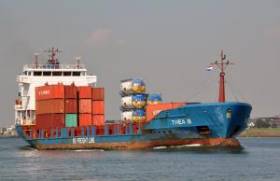Displaying items by tag: Manchester Ship Canal
'Rivers With Jeremy Paxman' Canal Boxboat Begins New Sea Service
#PaxmansBoxboat– Thea II the containership that featured in ‘Rivers with Jeremy Paxman’ on Channel 4, has completed the first sailing for BG Freight Line’s new Liverpool-Cork service this morning, writes Jehan Ashmore.
In the penulimate episode of the River series that focused on the Mersey, the 360 TEU capacity container Thea II was boarded by the former BBC Newsnight anchorman for a hop along the Manchester Ship Canal. In stark contrast to Thea's routine operations on the inland 36 mile /58km canal connecting to Liverpool, the vessel now has sea-going duties. The 94m vessel is currently berthed at the Port of Cork’s Tivoli Container Terminal.
BG Freight Line which is a fully-owned subsidiary of Peel Ports Group, operator of the Port of Liverpool, have introduced the new weekly container service to Cork. This is the first time that the two ports have been connected directly with a container lo-lo service. BG Freight Line also operate an Irish Sea feeder service network in which Afloat.ie monitored Thea II at the weekend call to Dublin Port.
As for new Mersey-Lee service, this will provide a quay-to-quay route for tank operators, and door-to-door opportunities into the North of England, Midlands and Scotland - regions previously only accessible via Dublin.
It is also intended that the new service will also allow customers from the south of Ireland to also make onward deep-sea services now calling at Liverpool, particularly from Canada, the east coast of the US and the Mediterranean.
In addition to Thea II, the Cork-Liverpool route will also be initially served by a sister RMS Veritas. At the end of the each week, whatever ship is serving will continue to offer services between Belfast, Greenock and Liverpool.
As Afloat reported last year, BG Freight will take delivery of four tailor-made short-sea feeder vessels optimised for the company’s Irish Sea Hub services. One of the new build ‘Green Vessels’ due to come into service in 2018, BG Diamond will operate on the new route.
Returning to Thea II, this containership begin service on the Manchester Ship Canal in 2014 having increased capacity of more than 100 TEU per sailing to that of the Coastal Deniz. When this containership was employed on the canal it too featured on a UK TV series ‘Ade to Sea’ as previously reported on Afloat.ie. On that occasion it was presenter comedian, Ade Edmondson who also boarded this ship along the waterway.
On the TV: ‘Ade to Sea’ Explores Manchester Ship Canal, Liverpool Docks and Giant Welsh Wind Farm
#OnTV – It may be the final episode of 'Ade to Sea' (tomorrow, Thursday on UTV at 8.30pm) however England's North West and notably the Manchester Ship Canal are to feature topics, among them those previously covered on Afloat.ie, writes Jehan Ashmore.
Asides the Guinness ships that once crossed the Irish Sea, the Manchester Ship Canal for example is where currently Kelloggs cereals are carried on the Coastal Deniz, a sister of containership Arslan II (formerly Coastal Isle) and having grounded off Arklow Bank in January. Following dry-docking in Dublin Port, Arslan II arrived in Turkish waters earlier this month.
Both sisters in recent years operated Coastal Container Line's Liverpool-Dublin service, in which the Peel Ports Group (owners of Liverpool Port) still operate the MTL container facility located beside the Poolbeg Yacht and Boat Club's marina. The Liffey-Mersey service is now run by BG Freightline.
Ade to Sea is presented by the comedian, Ade Edmondson, who over the last six episodes has set out to sail and explore Britain's maritime past and present and tomorrow night's broadcast, will see him head down the River Mersey to Liverpool.
The north western English port in the early 19th century represented forty per cent of the world's trade, and made Liverpool the busiest and most advanced port in the entire world. The present day port is undergoing a major development of a new riverside container terminal named Liverpool2.
Ade starts his journey at Eastham where the Manchester Ship Canal connects with the River Mersey. The ship canal transformed Manchester from a landlocked city into the third busiest port in Britain.
Also Ade explores the vital role of the tugboat, which towed large cargo ships up the narrow and shallow waters. He meets three generations of one family who run the tugboat business on the ship canal today and joins them as they tow a three thousand ton container vessel (the Coastal Deniz as pictured above) down the historic waterway.
Once back in Liverpool, Ade boards a triple masted topsail schooner, the Kathleen and May in which Afloat.ie has reported on. Tall ships like these made transatlantic journeys during 1800s.
Ade joins Scouser, Hughie Jones at sea to learn about how shanties or working songs were sung on the old boats that sailed out of Liverpool.
To learn more about what's happening off the north-west coast today Ade travels out eleven miles to sea where they're in the middle of building one of the largest wind farms in the world, Gwynt Y Mor.
The new wind-powered electricity generating facility is serviced by support vessels from Mostyn and offshore of Rhyl is the wind-farm's very own floating accommodation vessel, the Wind Solution.
For the last two years hundreds of people have been involved in preparing for one hundred and sixty wind turbines to be installed. Ade joins the men and women working on the wind farm overnight to get a rare insight into what it's like to work and live at sea.
Arthur's Day: Time to Reflect the Last Guinness Ships
The Lady Patricia represented the last of the more traditional Guinness vessels, though her predecessors The Lady Grania and The Lady Gwendolen differred in that they had split superstructures with the bridge admidships and accommodation quarters placed aft. Whereas The Lady Patricia had her superstructure positioned well aft.
In addition she was the last to carry a 'Lady' prefix name. She was named after the daughter of Lord Iveagh, Rupert Guinness, when entering service in 1962 from the yard of Charles Hill & Sons, Bristol. Her entry allowed the Guinness to be eventually replaced when she went to be scrapped at Faslane the following year.
Two deck-mounted granes that were used to hoist silver cylinders containing the beer where removed in 1973 from The Lady Patricia when she was converted into the world's first beer-tanker. The new method no longer required the cumbersome and time-consuming process of loading barrels from trucks. Instead trucks fitted with tanks transferred the liquid-cargo through pipes which involved pumped some 205,000 gallons or 1.87 million pints on board.
Unlike The Lady Patricia which was converted for tanker operations, the Miranda Guinness became the world's first custom-built beer-tanker when launched in 1976 from the Albion Shipyard also in Bristol. She also represented the last vessel to be launched (see PHOTO) there, after 156 years of shipbuilding.
Miranda Guinness was named by the Countess of Iveagh, after whom she was named. The newbuild replaced both The Lady Grania and The Lady Gwendolen which were sold. Since their launch The Lady Patricia and Miranda Guinness were registered in Liverpool until 1987 when the port of registry became Dublin. This arose following a change in the vessels management to Irish Marine Services Ltd, which was made up of former Irish Shipping Ltd management.
This arrangement only lasted to 1993 when Guinness discontinued the world's only beer-tanker shipping operation on the route linking Ireland and Britain. The process had allowed millions of pints to be served through the use of conveying the 'black-stuff' on board the dedicated beer-tankers or should that be those stout ships! Of the two vessels, the Miranda Guinness was the last to depart Dublin Port.
The ships were sold for scrapping on Merseyside and replaced in the form of 20-foot transportable tank trailers towed by trucks using Irish Sea ferry routes. Each of the silver tankers holds 10,000 gallons which is equivilant to 80,000 pints. It would take someone drinking 10 pints a day 22 years to drink it! Now that would be another challenge for the famous Guinness Book of Records!
In addition as we approach 17:59hrs, reflecting the 1759 date of the lease signing by Arthur Guinness, perhaps that minute could also be used to reflect a unique era in Irish brewing transportation methods and shipping history. By the way, Cheers to Arthur!
- River Liffey
- Ports and Shipping News
- Sir John Rogersons Quay
- Irish Shipping Ltd
- Guinness
- Guinness barges
- The Last Guinness Ships
- Arthur's Day
- The Lady Patricia
- Miranda Guinness
- Stout Ships
- Beer tankers
- Runcorn
- Manchester Ship Canal
- St. James Gate
- Stouttankers
- Charles Hiil & Sons Bristol
- Irish Marine Services Ltd
- Salford Docks
- Guinness concentrate
- Albion Shipyard Bristol































































